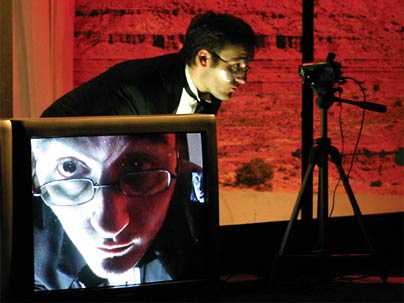MIT faculty discussed political, personal and practical aspects of the relationship between art and technology in a symposium held Wednesday, May 4, in the Kirsch Auditorium to honor the inauguration of President Susan Hockfield.
Associate Provost for the Arts Alan Brody opened the session, titled "Art, Technology and Public Space."
Krzystof Wodiczko, professor of architecture and director of the Center for Advanced Visual Studies; director Jay Scheib, assistant professor of music and theater arts, and composer Evan Ziporyn, Kenan Sahin Distinguished Professor of Music, presented talks and selections from their work.
Wodiczko is known internationally as an activist designer who uses technology to confront political and social oppression. His presentation, "Art, Technology and Democracy," included a talk and three videos of his work in Tijuana, Mexico, St. Louis and Hiroshima, Japan.
Wodiczko's work challenges "un-democracy and un-freedom" by "uncovering and bringing into the open hidden traces of inequality and by inserting into public spaces … those who should testify," he said.
For example, his Tijuana video projected individual faces of women who worked in factories ("maquiladoras") onto the dome of an elite local concert hall. The departing concert audience had to walk beneath the enlarged projected image and hear the amplified voice of a socially invisible woman describing violence in her life. This huge "ad hoc narrative" could bring both narrator and crowd "closeness to misery and recovery from trauma through speech," Wodiczko said.
Scheib has directed productions at MIT, in New York City and in Berlin, in Salzburg, Austria, and in Budapest, Hungary. His multimedia production of Chekhov's Platonov fragment, "In This Is the End of Sleeping," debuted at MIT and was shown at the New York Chekhov Now Festival.
Scheib outlined his personal directorial journey since 2001, focusing particularly on his interest in Russian romantic naturalism and his use of on-stage video to realize the genre's "one-on-one reality of humans under duress" for contemporary audiences. Media technology in this case made for more reality, he commented.
To illustrate, Scheib showed a video clip from "Demolition Downtown," a 1976 Tennessee Williams play into which Scheib introduced video cameras on stage, two television-sized screens that highlighted the action and a Plexiglas screen between the stage and the audience. The "Demolition" actors, under Scheib's direction, vividly showed duress, and the video footage intensified the drama.
"Technology produced more intimacy, more personality, and more specificity with gestures through the enlargements on screen," Scheib noted. Scheib said he expected his next work to lean toward dance.
Composer and clarinetist Ziporyn weaves traditional Indonesian orchestration with sonic threads from European classical, American jazz and bleeding-edge electronica in his work. Ziporyn has toured with Bang on a Can, which he founded in 1987, Paul Simon and DJ Spooky.
In his talk, "The Uncooperative Mirror: Composers and Computers," Ziporyn characterized technology as "all good" in its sheer practicality. Software enables people without notation skills to compose; it saves labor in copying music, and it offers a "vocabulary for improvising" thanks to which composers have developed or discovered an array of bright new sounds.
Technology also offers productive serendipity, Ziporyn noted. He played a selection from his own work, "Ocean," that was written "completely by accident. I composed it, accidentally pushed the INVERT button, and the piece was turned upside down and backward." He kept it as technology had remade it.
In "Be In," Ziporyn kept a piece technology had unmade. He lost 90 percent of "Be In" when his hard drive crashed, then rewrote the whole piece from memory. "It was better than the original," he said.
"Subtle downsides" to technology for composers show up in the "realm of labor management. We still have to make decent working conditions for people. Musical scores have to be written so people can play them. Thirty violinists can't agree like 30 oscillations," he said.
A version of this article appeared in MIT Tech Talk on May 11, 2005 (download PDF).






